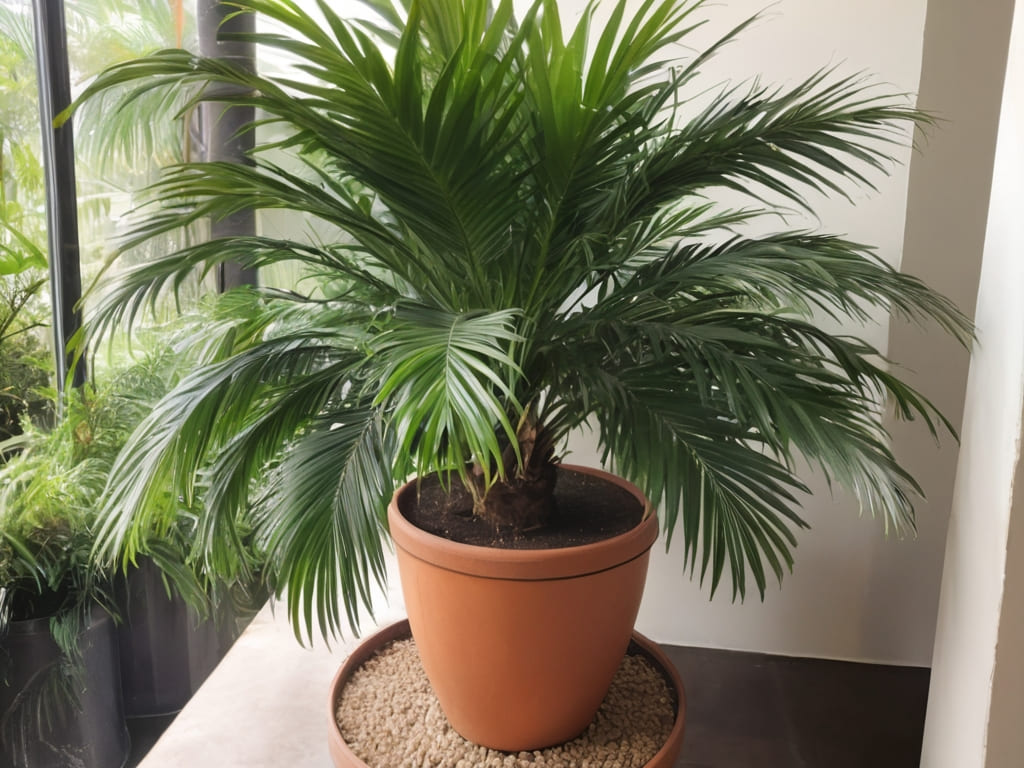
Areca Palm (Dypsis lutescens) is one of the hardiest and easiest houseplants to care for. With its lovely fan-shaped leaves emerging from its slender trunk, the areca palm instantly adds a tropical flair to any indoor space.
Key takeways:
- Appearance: Fan-shaped leaves, slender trunk, beginner friendly
- Light: Thrives in bright indirect light. Avoid direct sun
- Water: Water when top inch of soil is dry. Do not overwater
- Fertilizer: Feed spring to fall with balanced fertilizer
- Potting: Repot every 2-3 years in well-draining potting mix
- Propagation: Propagate from stem cuttings in water or soil
- Pests: Check for scale or mealybugs occasionally
In this article
Appearance of the Areca Palm

The areca palm has attractive, fan-shaped dark green leaves that emerge from an elegant slender trunk or stem. Mature palms can reach heights over 6 feet tall with leaves up to 2 feet long. Its small stature and low light/care needs make it an ideal plant for any home.
Light Requirements for the Areca Palm

The areca palm thrives in bright, indirect light. Direct sunlight can scorch its tender leaves. Under low light conditions, its growth may be stunted with fewer leaves.
| Light Conditions | Effect on Areca Palm |
|---|---|
| Bright Indirect Light | Thrives, producing full lush growth |
| Low Light | Slower growth, fewer leaves |
| Direct Sunlight | Leaf scorch possible, avoid prolonged exposure |
Watering the Areca Palm
Water when the top inch of soil is dry. Take care not to overwater, as soggy soil can cause root rot. Allow soil to dry out slightly between waterings.
- Check soil moisture weekly by poking your finger 1 inch deep
- Water thoroughly whenever soil is dry
- Avoid standing water in the saucer
Fertilizing the Areca Palm
Fertilizing the Areca Palm is essential for its growth and development. These plants are heavy feeders and require regular fertilization, especially during the growing season from spring to early fall. A liquid fertilizer with a 3-1-2 or 3-1-3 N-P-K ratio is recommended, preferably in a slow-release form. It is crucial to maintain the pH of the potting medium near 6.0 to keep fluoride unavailable to the plant. Be careful to avoid over-fertilization to prevent damage to the plant.
| Month | Recommended Dosage |
|---|---|
| Spring (March-May) | 1/2 strength every 2-3 weeks |
| Summer (June-August) | 1/2 strength every 2-3 weeks |
| Fall (September-November) | 1/2 strength monthly |
| Winter (December-February) | None, allow soil to dry between waterings |
Potting the Areca Palm

Kante 18 Inch Dia Round Concrete Planter, Large Plant Pot with Drainage Hole and Rubber Plug
Repot only when you notice roots growing from the drainage holes. Repot in a well-draining potting mix suitable for foliage plants.
- Check for circling roots and trim as needed
- Place palm in center of new pot and fill gaps with soil
- Water thoroughly after repotting
Propagation of Areca Palm
Propagate areca palms from stem cuttings is pretty easy. Follow these steps:
- Cut 6-8 inch stem below a fan of leaves
- Remove lowest leaves and place stem in water
- Roots should form within 4-6 weeks
- Pot rooted cutting in soil and keep warm and moist
Growth and Development of the Areca Palm
The areca palm thrives in indoor temperatures between 65-80°F with medium humidity levels around 50%. Consistent conditions will promote steady but gradual growth year-round.
RELATED: 9 Indoor Plants that Purify the Air
Managing Pests and Diseases for the Areca Palm
Common pests that can affect Areca Palms include spider mites, mealybugs, scale insects, and aphids. Regularly inspecting the plant for signs of infestation such as webbing, sticky residue, or visible insects is essential. To combat pests, gentle washing with insecticidal soap or neem oil can help control infestations.
Additionally, ensuring proper watering practices, adequate air circulation, and avoiding over-fertilization can prevent common diseases like root rot and leaf spot.
Frequently asked questions
How do I make my areca palm bushier?
Prune lower leaves to encourage branching and a fuller shape.
Can I keep an areca palm outdoors in summer?
Yes, protect from direct sun and bring in before night temps fall below 50°F.
What if my palm’s leaves are yellowing?
Check for overwatering or nutrient deficiency and remedy with better drainage and fertilizer.
With minimal care requirements, the areca palm makes an excellent addition for beginner and low-maintenance plant parents alike.
Happy gardening!







